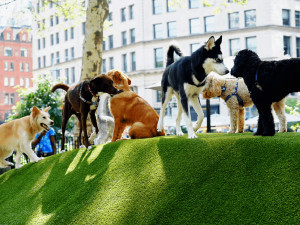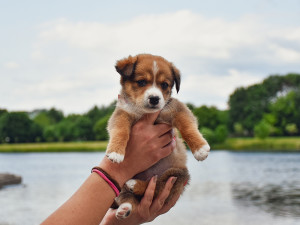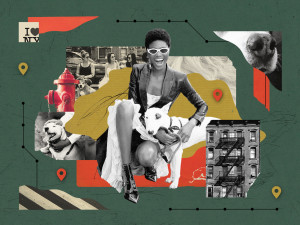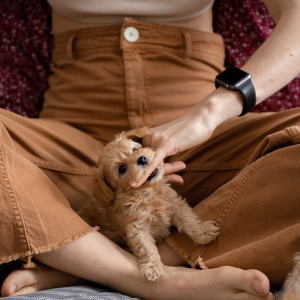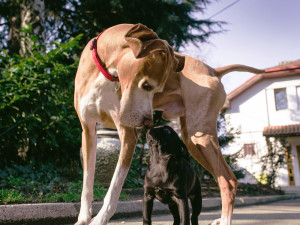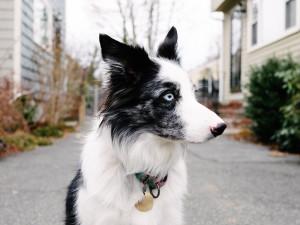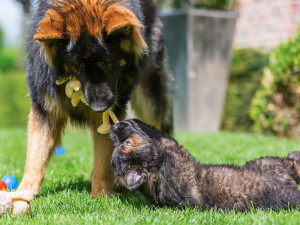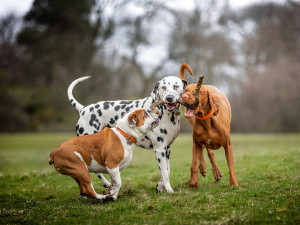Just Because You Can Bring Your Dog to the Bar, Should You?
We asked the experts if your pup actually wants to tag along for your Sunday Funday.
At first, it may have seemed like such a good idea to bring your dog to the bar. You love football, your friends, and French fries, so why not throw in your best pal with four legs? Cut to a few hours later, and you might be full of regret. You’ve got dog pee at your feet, a nervous, barking mess by your side, and a lot of annoyed customers giving you the death glare. How did it come to this?
Dog-friendly venues and events have been popping up everywhere, offering pet parents more opportunities to fold our dogs into our social lives. Still, it’s on us to ensure that wherever we go with our dogs, we’re putting their needs first. That means thinking carefully about where they’ll feel comfortable and where they won’t.
Our dogs are not human beings in fur coats, certified dog behavior consultant (CDBC) and accredited dog trainer (ADT) Emily Scottopens in new tab points out. “They have their own needs, and if their emotional barometer gets too high, we have to expect that they’re not going to handle things well.”
Are dog-friendly venues and events safe?
Generally, yes. The bigger question is whether your dog will feel safe.
How much do you spend on your pet per year?
Some events to avoid could include loud concerts and events where there will be a lot of wild animals present (you don’t want your dog attacking something that looks like “prey”), or outdoor events where there will be extreme weather, including heat. Although it might be counter-intuitive, you should also exercise caution when bringing your dog to an event where there will be a lot of other dogs. They’ll all likely be hyper-stimulated, which could spark negative encounters.
If you’re thinking of bringing your dog along pet-friendly spot, Scott advises taking four factors into account: their sociability, the environment, the level of training your dog has received, and your own ability to read their body language.
Is my dog social enough for a dog-friendly event?
The majority of dogs are selectively sociable, Scott says, which means that, like most of us, they enjoy friendly interactions with many (but not all) people and dogs. “If we understand that most dogs are selective,” Scott says, “then it’s up to the pet parent to say, ‘Is my dog social enough that they're going to be comfortable in this setting with people nearby, waiters coming up to the table, loud noises, all that kind of stuff?’”
If your dog doesn’t love hanging out with strangers and other animals, then these kinds of events are probably a no-go. But if your dog thrives in many or all situations, they could be a good candidate. But just because a dog loves to hang out with “his humans” doesn’t mean that they’ll get along with everyone or that they’ll enjoy a loud, rowdy bar setting. Regardless of how social your dog is, do your homework and plan ahead.
Should I take my dog to a bar or restaurant?
Next, it’s time to assess the environment. Consider variables, like how crowded it might feel, what the weather will be like, and how noisy it will be. Is your dog familiar with this kind of setting, or could it be overwhelming?
If possible, visit the venue beforehand without your dog to get the lay of the land and determine where you and your dog might be most comfortable. Then, try a practice run with your dog, picking a tucked-away location at the venue where they won’t be stepped on or approached by strangers.
“Observe your dog — observe what they're doing,” Scott says. Do they seem comfortable and ready to party, or are they cowering behind your legs? If you see the latter, “then that's a red flag that your pup is not happy.”
If your dog feels out of their element, they could become stressed or overstimulated, which could lead to a negative experience for you both. “Some dogs may be generally comfortable with people and dogs but become overwhelmed or stressed with the unpredictable nature of crowds, tight spaces, and loud noises or music,” says Sammye Darling, a certified professional dog trainer.
Avoid surprises by calling ahead. Scott recommends asking about leash policies, whether there will be shady areas for outdoor activities, and what the pet relief situation will look like. Darling urges pet parents to make sure their dog’s vaccines are up to date.
If you’re attending an event by yourself, make a plan for what you’ll do when you need to use the restroom. “Many people forget to consider using the restroom at an event,” Darling says. “This often requires bringing a dog to an area with multiple stall doors opening and closing, and the noise of flushing toilets, hand dryers blowing, and running sinks with people coming and going can be very foreign to your dog.”
Does my dog need training for a dog-friendly event?
Your third consideration should be whether your dog has the necessary socialization and training. As Scott puts it, “Does the dog have enough skills to be able to settle and be a good citizen in these environments?” If your dog doesn’t know how to behave, or if they’re likely to become overstimulated or nervous, Scott says, “you’re setting the dog up to fail.”
Darling suggests that pet parents think honestly about how well their dogs’ training will stand up to a distracting environment. Will they remember to sit, stay, and leave it while people are walking and talking around them? Can they walk well on a leash without veering into others’ personal space, even when there’s food or drinks spilled on the floor? If not, Darling says, “it might be best to work on some training skills first before bringing your dog to a pet friendly event or bar.” Scott often uses pattern gamesopens in new tab to help dogs stay focused and calm.
“If you’re concerned that your dog may not be well-socialized or trained enough to comfortably interact with other dogs and people in the environment you’re planning to visit, when in doubt, you can ask a professional dog trainer to help you interpret your dog’s body language and skill level,” Darling says. “You could join local group dog training classes or practicing obedience skills in pet-friendly areas to build their confidence and comfort.”
If this is starting to sound like a lot of work, that’s because if you’re doing it right, it is. As crucial as it is to make sure our dogs are adequately trained for an outing, it’s just as important to make sure that we have the bandwidth to monitor their happiness and protect their wellbeing. That can be a lot if you’re, say, trying to keep up with a football game or vibe out at a concert. If you’d rather not split your attention, the answer is simple: don’t bring your dog.
How can I tell if my dog is scared?
Your last step is making sure that you understand your dog’s body language. Too often, Scott says, she sees pet parents who fail to notice when their dog is unhappy. “I get frustrated when I go to venues and I see these dogs that aren't actively aggressive or lunging, but they're miserable, and the owners don't see that.”
Subtle signs that your dog is feeling vulnerable could include behaviors like yawning, lip-licking, stretching, tucked tail and ears, restlessness, a stiff body, sharp eyes, lowered posture, excessive panting or sniffing, scratching, raised hackles (meaning, the hair along their spine is sticking up), turning away from people, or rejecting food. More obvious cues include barking or lunging, shaking, growling, snapping, showing teeth, or snapping.
“If you notice signs of discomfort or stress, consider finding a quieter area where your dog can rest, or leave the event if necessary,” Darling says. “Provide your dog with breaks from the environment to reduce overstimulation and allow them to calm down.”
What should I bring to a dog-friendly venue or event?
Even if a venue or event says they’ll have everything, it’s best to bring your own supplies. Keep your dog on a flat leash (meaning, not a retractable or stretchy leash) and make sure they’ve got their tags and a registered microchip in case they get lost.
Bring poop bags, hand sanitizer, anti-bacterial wipes, and something absorbent in case of accidents. You’ll need water and a portable bowl, and it’s good to bring at least one toy. If the ground is going to be hot, snowy, or icy, bring dog shoes, and if it’s cold, make sure your dog is wearing proper outerwear just like you. And wherever you’re going, look up the nearest emergency vet just in case.


